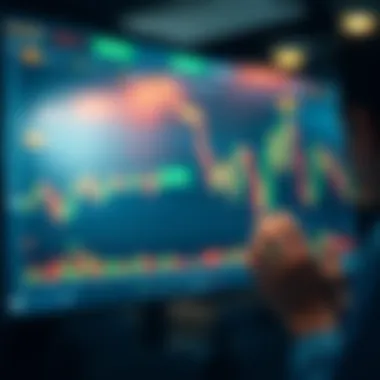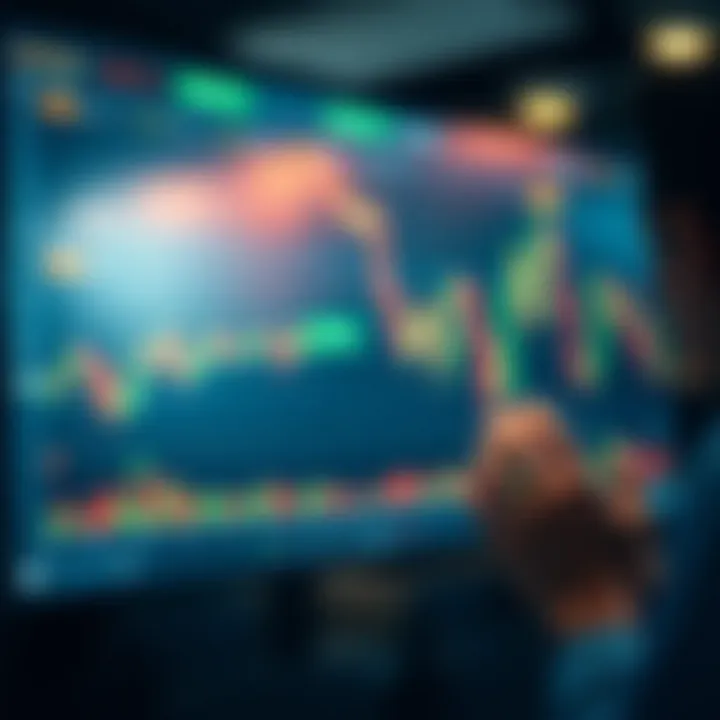Discovering Free Charting Tools for Cryptocurrency Trading


Intro
The world of cryptocurrency is rapidly evolving, drawing in a diverse crowd of traders, techies, and everyday folks with an eye for investment. As more people explore the cryptosphere, the demand for sophisticated tools to analyze these digital currencies increases. Among these tools, charting software plays a pivotal role. It helps traders make sense of the volatile market movements, assess trends, and execute informed decisions. With numerous options available, many traders, especially those new to the game, may wonder where to start.
Having access to effective charting software can be the difference between a profitable trade and a costly mistake. In this guide, we will not simply skim the surface but plunge into the nuances of free charting software designed specifically for cryptocurrency trading. From extracting meaningful insights to navigating technical analysis, this article aims to equip you with the information to selections suited for your unique trading style.
Key Concepts in Cryptocurrency
Definition and Importance
Before settling on charting software, understanding cryptocurrency itself is crucial. At its core, cryptocurrency is a digital or virtual form of currency that leverages cryptography for secure transactions. Unlike traditional currencies issued by governments, cryptocurrencies operate on decentralized networks based on blockchain technology. The significance of cryptocurrencies lies in their ability to democratize financial transactions, enabling peer-to-peer exchanges without mediators such as banks or payment processors.
With a plethora of cryptocurrencies available—think Bitcoin, Ethereum, or even newer entrants like Solana—the need for precise and real-time analysis becomes ever more urgent. This is where the free charting software steps in, providing tools that can help traders interpret the data on their digital investments effectively.
Blockchain Technology Overview
Unearthing the potential of cryptocurrencies requires some knowledge of blockchain technology. Blockchain, simply put, is a distributed ledger that records all transactions across a network of computers. Each block in the chain contains a number of transactions, and when filled, it’s linked to the previous block. This creates a secure and immutable chain of records that is almost impossible to alter or hack.
Understanding this technology is vital, as it underpins the various cryptocurrencies and affects their price movements. Stakeholders, developers, and traders need to grasp how blockchain works to better analyze trends and potentials in different cryptocurrencies. Knowing this context can guide your decisions on which cryptocurrencies to invest in and how to read the charts that illustrate their market performance.
Trends and Innovations
Emerging Cryptocurrencies
As the crypto market expands, new cryptocurrencies are hitting the scene regularly. While Bitcoin and Ethereum still dominate the market, it's essential to keep an eye on emerging players. These new entrants can offer innovative solutions or unique features that might be appealing. Keeping abreast of these developments can open new avenues for investment and profit.
Notable mentions include cryptocurrencies like Cardano and Avalanche, which are gaining traction due to their unique algorithms and scalability. Having software that allows you to track and analyze these new currencies efficiently is indispensable.
Technological Advancements in Crypto
Tech is always on the move, and cryptocurrency is no exception. Innovations such as DeFi (Decentralized Finance) are reshaping the landscape, creating new opportunities and complexities. Plus, artificial intelligence is starting to play a role in analytics and forecasting. Charting software that integrates such advancements might offer more refined insights, giving traders a competitive edge.
"The investment climate is shifting faster than a cat on a hot tin roof; staying updated is critical."
For those looking to navigate this volatile terrain, knowledge is power. As you consider your options in charting software, realize that it’s not just about having a tool; it’s about having the right tool that aligns with your investment strategies and market trends.
Understanding Charting Software
Charting software has become a critical component in the toolkit of cryptocurrency traders, influencing their decisions and strategies. With the market for cryptocurrencies often resembling a roller coaster ride, the need for precise analysis and visual insight cannot be overstated. In essence, charting software transforms raw data into meaningful visual representations, aiding traders in making informed choices.
Definition and Purpose
At its core, charting software provides a platform for creating charts that visualize price movements over time. These graphs offer a snapshot of market trends, allowing users to interpret complex data in a straightforward way. Simply put, a trader can input market data and receive graphical representations of prices, volumes, and market indicators.
However, charting software does more than just present data visually. Its real purpose lies in empowering traders to identify patterns, understand market sentiments, and make forecasts based on analytic insights. Traders often rely on various configurations of charts, whether they be line charts, candlestick charts, or bar charts. Each serves a different purpose, tailored to the needs of varying trading strategies.
Importance in Cryptocurrency Trading
In the world of cryptocurrency trading, understanding charts can be the difference between hitting the jackpot or facing a major loss. For instance, being adept at reading a candlestick chart, which shows the open, high, low, and closing prices of a cryptocurrency, allows traders to spot potential reversals or continuations of trends more effectively.
Moreover, the cryptocurrency market is notably volatile, with prices changing rapidly. In this environment, having access to powerful charting tools helps traders seize opportunities and hedge against risks. The importance of chart accuracy and accessibility cannot be understated; with free charting software, both novice and experienced traders can access tools previously reserved for institutional investors without breaking the bank.
"In volatile markets, timing can be everything. Charting software illuminates the shadows of the unknown, guiding traders toward their next move."
Tools such as TradingView and Coinigy have democratized access to market analysis, allowing for real-time trading decisions based on observable trends. In a sense, the true value of charting software lies in its ability to facilitate swift, informed trading actions. So whether you are a budding enthusiast or a seasoned trader, embracing the full potential of charting software is paramount.
Types of Charting Software
The landscape of cryptocurrency trading demands precision and informed decision-making, and this is where charting software plays a pivotal role. Understanding the different types of charting tools available can notably impact a trader's experience and strategy. Each type of software comes with its unique set of benefits, features, and considerations.
Web-Based Solutions
Web-based charting platforms are becoming more favored among traders for their easy accessibility and cross-device functionality. They typically operate in a browser, eliminating the need for downloads or installations. This means that for a trader on the go, accessing real-time charts isn't a hassle — just open up a site and start analyzing.
One of the major advantages of web-based solutions is their collaboration features. Many of these platforms allow traders to share their screens and charts with others, making peer feedback and discussion seamless. Plus, they often come packed with a range of technical indicators and chart customization options without the headache of complex installations.
However, they are sometimes dependent on internet connectivity. A poor connection can hinder real-time data updates, and this could mean a missed trading opportunity. On the flip side, many modern web-based solutions are up-to-speed, utilizing cloud services to ensure that data update almost instantly.
Desktop Applications


Desktop applications generally offer a more in-depth and powerful experience for serious traders. These programs usually require installation on a specific device but can provide robust functionality that web-based tools might lack. Features like extensive chart customization, advanced technical indicators, and even scripting for personalized trading strategies are common with desktop applications.
"Desktop trading software is like a toolbox for an artisanal craftsman; the more tools you have, the finer your craft can be."
The lack of reliance on the internet can also be a big plus. Once installed, you can work offline, which is crucial when conducting extensive analyses that don't require constant data inflows. However, not all desktop applications are intuitive. Some might present a steep learning curve that discourages newcomers.
Another point is that while they might offer more features, they can sometimes be bulky or resource-intensive, which can slow down older machines. Yet, for those willing to invest the time and effort, the rewards can be quite significant.
Mobile Apps
In an era where mobility is king, mobile apps are carving out their own niche in the realm of charting software. These applications provide traders the means to analyze markets and place trades directly from their smartphones. Quick access and responsive design make them essential for traders who cannot carry their desktops everywhere.
Real-time alerts and push notifications keep users updated on price movements or specific conditions. With a well-designed app, traders can set alerts for specific price points, helping them to jump in or out of trades at the right moment.
Yet, while they offer convenience, mobile apps often come with limitations regarding the depth of analysis and data presentation when compared to their web-based and desktop counterparts. Screens are smaller, which can make extensive chart analysis cumbersome. Furthermore, mobile apps might not be as consistent in displaying complex technical indicators, which are often crucial for data-driven trading strategies.
Key Features to Look For
When wading through the sea of charting software available for cryptocurrency, it’s essential to know what features can make or break your trading experience. Charting software is not just about pretty graphs; it’s pivotal to your trading strategy and overall performance. The right features could mean the difference between a profitable day and a major loss. Here are some key aspects that shouldn’t be overlooked:
User Interface and Experience
A clean, intuitive user interface can significantly impact how quickly you can analyze data and make decisions. Users, especially those new to cryptocurrency trading, often feel overwhelmed by cluttered screens and complex navigational structures. A good platform simplifies the process, allowing traders to focus on the charts rather than deciphering the software itself. Interaction speed is also key—when you're making fast decisions, lag can lead to losses. Look for software that offers a straightforward design and customizable dashboards which enable you to see only what you need when you need it.
Chart Customization Options
The ability to customize charts is a crucial feature that can enhance the trading experience significantly. What works for one trader might not be effective for another. Customization allows users to tailor their charts to fit their strategies. This might involve changing colors, chart types, or adding various technical indicators. Users should seek out platforms that offer extensive customization features, as this flexibility can help in identifying trends that align with individual trading styles. Ultimately, customization empowers traders to create visual representations of data that make sense to them.
Technical Indicators
Technical indicators act like breadcrumbs in the forest of data. They provide insights about market trends and help in predicting future movements. Look for charting software that includes a rich selection of indicators like Moving Averages, Relative Strength Index (RSI), and Fibonacci retracement levels. These indicators can assist traders in spotting entry and exit points. Moreover, the ease of adding sophisticated indicators without complex setups can save you valuable time, letting you focus on strategy rather than software functionality.
Data Types and Sources
The integrity of your trading decisions heavily relies on the accuracy of the data you are using. Thus, it’s imperative that the charting software you choose provides access to reliable data sources. Data types may include historical price data, real-time quotes, and even news feeds that can influence trading dynamics. When evaluating platforms, check if they offer comprehensive market coverage and various crypto assets. Connecting to multiple exchanges for real-time data can also enhance your market visibility, especially in the fast-paced world of cryptocurrency trading.
"In trading, your edge lies in the data you have and how well you can interpret it. Robust charting features can make all the difference."
Top Free Charting Software for Cryptocurrency
The world of cryptocurrency trading is fast-paced and ever-changing. When it comes to making informed trading decisions, having the right tools is essential. Charting software plays a crucial role in this process by providing visual representations of market data, allowing traders to analyze trends and make predictions. In this section, we will explore some of the top free charting software available for cryptocurrency traders. Each option offers unique features, catering to a variety of preferences and skill levels. By understanding these tools, traders can better equip themselves for the challenges ahead.
TradingView
TradingView stands out as a popular choice among cryptocurrency traders. This platform offers a user-friendly interface with a comprehensive array of tools and features. Traders can access real-time data, leverage social networking elements, and even share their analyses with the community.
One of its key strengths is the variety of technical indicators it provides. Over 100 indicators are available for traders to utilize, making both basic and advanced strategies feasible. Furthermore, the charting capabilities are robust, allowing for extensive customization. You can adjust time frames, add alerts, and even apply different chart types such as bar, candle, or line charts. The flexibility encourages experimentation, which is vital in the volatile world of cryptocurrency.
Additionally, TradingView integrates with numerous exchanges, providing a seamless experience for traders. It has a distinct community aspect where users can follow each other, share insights, and engage in discussions. This collaborative environment enables traders to learn from one another, gaining perspectives that can lead to improved trading strategies.
Coinigy
Coinigy offers a slightly different approach by emphasizing not just charting but also trading capabilities. This platform integrates with multiple exchanges, allowing users to trade directly from its interface. This singular point of access can be a time-saver for traders managing multiple assets across various exchanges.
The charting features in Coinigy are quite impressive, providing over 75 technical indicators and a variety of drawing tools. Users can analyze data from various time frames and even employ candlestick patterns to refine their strategies. The responsive design makes it easy to navigate, regardless of the device you are using, whether it’s a desktop or mobile.
However, one point to note is that Coinigy's free version comes with limitations regarding access to advanced features, which are primarily available in the paid subscription. Still, it remains a solid choice for traders who wish to experiment with real-time data and trading against a variety of cryptocurrency markets.
Cryptowatch
Cryptowatch distinguishes itself with a clean and minimalist interface that focuses heavily on data. This platform is particularly beneficial for those who prefer a streamlined experience without unnecessary distractions. It allows for extensive market analysis across multiple exchanges and cryptocurrencies, making it easy to compare prices and trends.
What makes Cryptowatch notable is the diversity of charts and data visualization tools it offers. Users can easily overlay indicators and compare data from different cryptocurrencies, providing a comprehensive overview of the markets. They also offer customizable alert notifications, which can keep traders informed about significant price movements. Users can set alerts for price levels or changes in volume, ensuring they never miss an opportunity.
The downside is, while it’s free to use, some advanced functionalities may require subscriptions. However, for sheer data analysis and price tracking, Cryptowatch is hard to beat.
ChartEx
ChartEx is somewhat lesser-known but worth mentioning for its specific focus on technical analysis. The platform allows users to create detailed, customizable charts with a variety of indicators and tools. One of its standout features is the ability to perform historical data analysis, which is critical for backtesting trading strategies.
Among its offerings, ChartEx provides advanced drawing tools, such as Fibonacci retracement lines, which can be a game-changer for traders using technical analysis. Moreover, the interface is designed to be intuitive, allowing even novice users to quickly learn how to navigate its features.


While ChartEx might not be as feature-rich as some of its competitors, its focus on simplicity and effectiveness makes it a viable option for traders who appreciate straightforward functionality over a myriad of flashy features.
Each of these platforms offers unique capabilities that cater to different types of traders. Whether you’re looking for extensive data analysis, trading integration, or community engagement, there’s a free charting software available that will enhance your cryptocurrency trading experience.
Comparison of Features Among Charting Tools
When it comes to navigating the choppy waters of cryptocurrency trading, the selection of the right charting tools can make or break the experience for traders—both seasoned and newcomers alike. The section on comparing features among charting tools provides a roadmap to make a wise choice in an environment saturated with options. Charting software might vary widely in capabilities, usability, and adaptability. Hence, understanding these variances can help traders harness the full potential of these platforms.
User Accessibility
User accessibility is paramount in charting software, particularly for those who may not have extensive technical backgrounds. A user-friendly interface can diminish the steep learning curve and help traders focus on analyzing markets instead of grappling with complicated setups. Tools like TradingView and Coinigy offer feature-rich environments but are designed with intuitive navigational elements in mind. This level of accessibility becomes even more beneficial during volatile market conditions.
In addition, account creation ease also plays a key role—some platforms provide a quick sign-up process using social media accounts or email logins, while others might require more cumbersome credentials. In terms of user accessibility, the ideal software is one that caters not only to experienced traders but also adopts a welcoming stance toward newcomers.
Network Compatibility
In today's interconnected world, network compatibility has become a crucial aspect of choosing charting software. Cryptocurrency investors often trade across various platforms and networks, so a charting tool that seamlessly integrates with numerous exchanges can save traders a significant amount of hassle.
For instance, tools like Cryptowatch excel in integrating data streams from multiple exchanges, which allows for real-time monitoring. This adaptability means traders don't have to jump between platforms or lose out on time-sensitive opportunities. Furthermore, cross-device compatibility is another key point, as traders benefit from being able to access their charts and analyses on desktops, tablets, or smartphones without breaking a sweat.
Support Services
Robust customer support can be a lifesaver when navigating through technical issues or unresolved queries about a trading platform. The variety in support options—whether it’s live chat, email, or comprehensive knowledge bases—can greatly impact the user experience. If a trader finds themselves stuck, knowledge bases with FAQs, video tutorials, and community forums can offer the necessary assistance to overcome obstacles.
Also, the support response times matter. A platform that responds swiftly can mean the difference between capitalizing on a market movement and missing out entirely. Some tools even offer community-driven support, enabling users to seek help from fellow traders who might have faced similar challenges.
"The right charting tool is not just a software choice; it's the foundation for informed trading decisions."
In summation, comparing the features of charting tools is a fundamental exercise for any trader stepping into the world of cryptocurrency. User accessibility ensures you can dive into the market without wading through confusion, network compatibility lets you stay agile regardless of the platform, and robust support services provide peace of mind when questions arise. Making informed comparisons can turn the tides in favor of strategic trading and informed decision-making.
Benefits of Using Free Charting Software
In the rapidly changing world of cryptocurrency trading, the ability to analyze market trends is paramount. Free charting software becomes not just a helpful tool but a lifeline for many traders navigating this complex landscape. The advantages of using these tools often outweigh the drawbacks, especially for those still finding their feet in the volatile crypto market. Here’s a closer look at the key advantages that make free charting software a sought-after resource for both seasoned investors and newcomers alike.
Cost-Effectiveness
When it comes to trading, every cent counts, and free charting software delivers a substantial benefit right off the bat—it's cost-effective. Investors can access powerful charting and analytical tools without spending a dime. Unlike premium software that often demands high fees, these free alternatives provide ample resources to those unwilling or unable to commit financially. This is especially crucial in a market characterized by fluctuations and uncertainties.
For example, platforms like TradingView offer basic features for free, allowing users to start tracking, analyzing, and executing trades without the burden of subscription fees. Subsequently, traders can dedicate their capital to purchasing cryptocurrencies rather than on analytical tools. The fiscal prudence associated with free software creates an ideal opportunity for traders to hone their skills without financial strain.
Accessibility for Beginners
The crypto landscape can resemble a foreign country for those just embarking on their trading journey. Free charting software makes this unfamiliar territory much more navigable. With user-friendly interfaces and instructional materials, these platforms open the door for beginners who might feel overwhelmed by the complexity of cryptocurrency trading.
For instance, Coinigy is known for its simplicity, making it suitable for newbies while still offering advanced tools for seasoned traders. The learning curve becomes less steep when beginners can utilize resources and tools when they choose to, empowered by their own pace of understanding. Additionally, many platforms provide tutorial videos and user forums that foster a collaborative learning environment. Such accessibility means that trading becomes not just an option for the financially savvy, but for anyone eager to learn.
Community and Resource Sharing
One of the often overlooked benefits of free charting software is the vibrant community that surrounds these platforms. Users often share their experiences, trading strategies, and analytical insights. By utilizing these platforms, traders not only gain tools but become part of a network of like-minded individuals with a shared interest in cryptocurrency.
Platforms like Reddit or Facebook groups can augment this community aspect, where users engage in discussions about their experiences with specific software—sharing tips, tricks, and even cautionary tales. This sense of belonging can be crucial for beginners feeling lost or isolated in their trading journey. Moreover, these communities foster the exchange of resources and knowledge that can prove to be invaluable in understanding market dynamics and decision-making processes.
"A single candle can light a thousand others; free charting software can spark a community of traders into action."
Challenges with Free Charting Software
Navigating the world of cryptocurrency is akin to standing in a bustling market – vibrant, chaotic, and full of opportunities. However, for many traders who opt for free charting software, this journey is not without its hurdles. Understanding the challenges that come with these tools is crucial for maximizing their potential and ensuring accurate trading decisions.
Data Accuracy Issues
When it comes to trading, data accuracy is king. Relying on flawed data can lead to disastrous outcomes, especially in the highly volatile cryptocurrency market. Free charting software often sources data from limited exchanges or uses delayed feeds. As a result, traders may make decisions based on outdated or inaccurate information. For instance, if you’re analyzing the price trends of Bitcoin and your chart is pulling data from an exchange known for inconsistencies, the signals you receive could dance to a different tune compared to the overall market.
Regular discrepancies in price can cause traders to miss out while the market shifts beneath their feet. Therefore, understanding the sources of your data and verifying their reliability should be a priority when employing free tools. Look for software that openly details its data providers to reduce risks associated with inaccuracy.
Limited Features Compared to Paid Software
While free charting software can provide the basics, they often fall short when it comes to advanced features. Traders seeking an array of technical indicators, additional chart types, or complex analysis tools may find themselves wanting. For example, many premium options offer sophisticated strategies like multi-timeframe analysis or the ability to backtest trading algorithms, which can be pivotal for developing robust trading strategies.
Free versions may offer some technical indicators but lack the depth and breadth available in their paid counterparts. Thus, traders might find themselves fighting with limitations that don’t serve their trading style. If you envision serious trading or investment strategies, investing in a more feature-rich software could be the way to go, as it might pay dividends in the long haul.


Interruption and Downtime
Another common frustration in the world of free charting solutions is interruption and downtime. Since many of these platforms rely on donations or ad revenues, the level of support may not be as reliable as premium services. When the market is hot, the last thing a trader needs is an unresponsive application. If a platform crashes or becomes overloaded during peak trading times, it can hinder your ability to make quick decisions.
Moreover, constant maintenance or unexpected outages can disrupt your trading routine. It's wise to choose a platform with a good reputation for uptime and robust customer support. Being left high and dry when the market matters most can lead to missed opportunities and unexpected financial losses. As the saying goes, "Time is money," and in trading, every second counts.
In summary, while free charting software offers valuable tools for traders, they come with their share of limitations. By recognizing potential data accuracy issues, feature constraints, and vulnerability to downtime, traders can make more informed decisions and better prepare themselves for a successful trading journey.
How to Make the Most of Free Charting Software
Using free charting software effectively can be the difference between making a profit and suffering a loss in the volatile world of cryptocurrency trading. The tools available are powerful but require some knowledge to harness their full potential. Many traders jump in headfirst without a solid understanding of how to utilize these platforms, often getting lost in the sea of indicators and options. Therefore, it’s essential to grasp the strategies for maximizing these tools. Whether it's through establishing a clear trading plan, engaging in regular analysis, or tapping into community resources, knowing how to make the most of these free charting solutions can significantly enhance trading success.
Establishing a Trading Plan
A trading plan acts like a roadmap for your trading journey. It should define your trading goals, risk tolerance, and the strategy you'll employ using the charting software. Without a structured plan, you might find yourself wandering aimlessly in the unpredictable crypto market.
When crafting your plan, consider the following points:
- Define Goals: Ask yourself what you want to achieve. Are you aiming for short-term gains, or are you more interested in long-term investments?
- Risk Management: Determine how much of your portfolio you are willing to risk on any single trade. It’s wise to avoid putting all your eggs in one basket.
- Entry and Exit Strategies: Decide on the conditions under which you'll enter or exit a trade. Utilize the charting software to set these criteria based on historical data and your technical indicators.
Your plan is your best friend in the chaotic world of trading. Stick to it to avoid emotional decision-making.
Regular Analysis and Practice
The cryptocurrency market operates 24/7, which means constant changes and opportunities. Regular analysis becomes crucial to keep up with these fluctuations. Utilize your charting software to perform daily or weekly assessments, which can inform your decisions.
- Track Your Trades: Analyzing your past trades will provide insights into what worked, what didn’t, and why. Use the historical data tools provided by your charting software for this.
- Adapt Strategies: Don’t be afraid to tweak your approaches as you learn. If your current techniques aren't yielding the expected results, use the charting software to explore new strategies or indicators.
- Simulations: Many platforms offer backtesting features, allowing you to practice your strategies without real financial risk. This can be invaluable for building confidence and honing your skills.
Utilizing Community Resources
Cryptocurrency trading is not an isolated activity. The community around it is rich with knowledge and resources. Engage with online forums, Reddit threads, and social media groups dedicated to cryptocurrency and trading.
- Sharing Insights: Many traders share strategies and experiences online. Learn from their successes and mistakes.
- Tutorials and Webinars: Seek out educational content that others in the community might offer. Investing time in learning can pay dividends in the future.
- Networking: Building connections with other traders can provide support, collaboration, and even potential mentorship. This interaction can enrich your trading experience and help you navigate challenges more adeptly.
By integrating these strategies into your use of free charting software, you'll develop a more structured approach to cryptocurrency trading, allowing you to make more informed decisions.
Future Trends in Charting Software
As we venture deeper into the realm of cryptocurrency trading, the landscape of charting software is undergoing substantial transformation. Future trends in charting software are not just about the tools themselves, but also about how they can enhance the trading experience and improve decision-making. With the ongoing advancements in technology, certain key elements stand out that can provide tremendous benefits to traders. These trends are essential to consider for anyone navigating the complex world of cryptocurrency.
Integration with Artificial Intelligence
The integration of artificial intelligence into charting software is reshaping how traders interpret and analyze data. AI can process vast amounts of information far quicker than any human, making it possible to identify patterns that may go unnoticed. This is particularly crucial in a market as volatile as cryptocurrency, where split-second decisions can have significant implications.
- Predictive Analytics: AI-driven tools can provide predictive insights based on historical trends. For instance, if a specific pattern has preceded a price increase, AI can recognize that pattern and suggest similar trends. This feature not only boosts confidence but also enables traders to position themselves advantageously.
- Personalized Trading Strategies: With machine learning, charting tools can adapt to an individual trader's style and risk tolerance. For example, the software might analyze past trades to discover what works best for the user, subsequently suggesting customized strategies tailored to their preferences.
- Automated Reporting: AI can generate reports with actionable insights much more efficiently than traditional methods. Traders can receive instant feedback on their performance and metrics without getting bogged down in tedious data analysis.
The use of AI in trading can lead not just to better decision-making but to a seamless trading experience all together.
Emerging Technologies
Aside from AI, other emerging technologies are redefining the capabilities of charting software. The rapid advances in areas like blockchain integration, augmented reality, and the Internet of Things (IoT) are paving the way for innovative tools that can adapt to the dynamic nature of cryptocurrency.
- Blockchain Integration: With decentralized networks becoming more prevalent, the integration of blockchain technology can enhance transparency in trading. Charting tools that use blockchain allow for real-time verification of transactions and provide an immutable record of trades, building trust among users.
- Augmented Reality (AR): Although still in its infancy, AR may soon find its way into trading platforms. Imagine layering market data over real-world views through AR glasses. Traders could analyze market movements while on the go, combining visual insights with real-time data.
- IoT Devices: The rise of IoT can present new ways for traders to access data. For instance, devices could send instant alerts about market fluctuations, ensuring that important updates are received wherever the trader is.
As these technologies continue to develop, the possibilities for charting software are nearly limitless. It's imperative for traders to keep an eye on these trends to ensure they are leveraging the most advanced tools available.
In sum, the future of charting software is not merely a matter of aesthetics or user interface improvements. Instead, it encompasses a fundamental shift towards more intelligent, adaptive tools that can democratize access to sophisticated trading strategies. Staying ahead in this rapidly evolving environment could determine a trader's success in cryptocurrency.
Epilogue
In wrapping up this exploration of free charting software for cryptocurrency, it's vital to underscore its significance in today’s trading landscape. Charting software serves as the backbone for traders seeking to make sense of market movements, especially considering the volatility inherent in cryptocurrency. Free tools like TradingView and Cryptowatch provide an entry point for both novice and veteran traders alike, democratizing access to crucial market analysis tools. This availability lowers barriers to entry, allowing anyone with a keen interest to engage with, and potentially profit from, the digital asset market.
Summary of Key Insights
Throughout the article, we diligently looked at several angles surrounding free charting software. The central takeaways include:
- User Accessibility: Many platforms are designed to cater to users with varying levels of expertise, providing intuitive interfaces and learning resources for beginners.
- Data Sources and Indicators: Reliable data alongside a multitude of technical indicators can greatly enhance trading potential, allowing for informed decision-making.
- Cost-Effectiveness: Free software options allow traders to access sophisticated tools without the financial burden, leveling the playing field in a competitive market.
Drawing from various features and capabilities, it’s evident that choosing the right charting software is crucial, as it can significantly affect trading outcomes and strategies.
Encouragement for Continuous Learning
As we step into the future of cryptocurrency trading, the importance of ongoing education cannot be overstated. The digital currency market is in a constant state of flux, affected by technological advancements, regulatory shifts, and global economic changes. Engaging with community resources on platforms such as Reddit and other forums can bolster knowledge and provide insights into emerging trends. Additionally, utilizing features like historical data analysis within charting software can further develop analytical skills.
Investing time into understanding market behavior, coupled with the use of sophisticated charting tools, will not only enhance trading strategies but also empower individuals to adapt to unforeseen market conditions. As the saying goes, "Knowledge is power"—and this saying rings even truer in the fast-paced world of cryptocurrency trading.
"To succeed in trading, one must stay informed and continuously adapt. The tools at your disposal can only aid you as much as the knowledge you apply with them."















